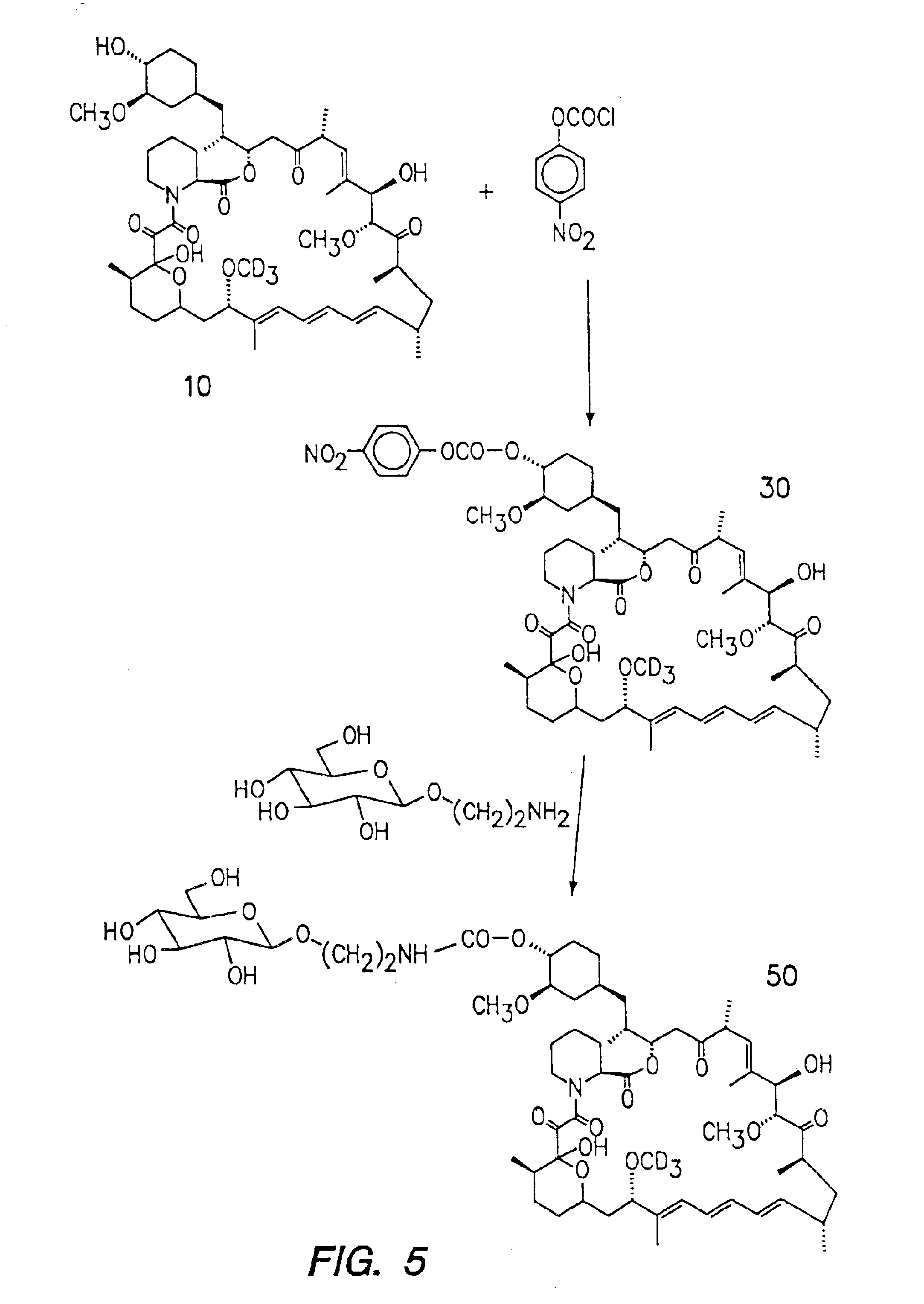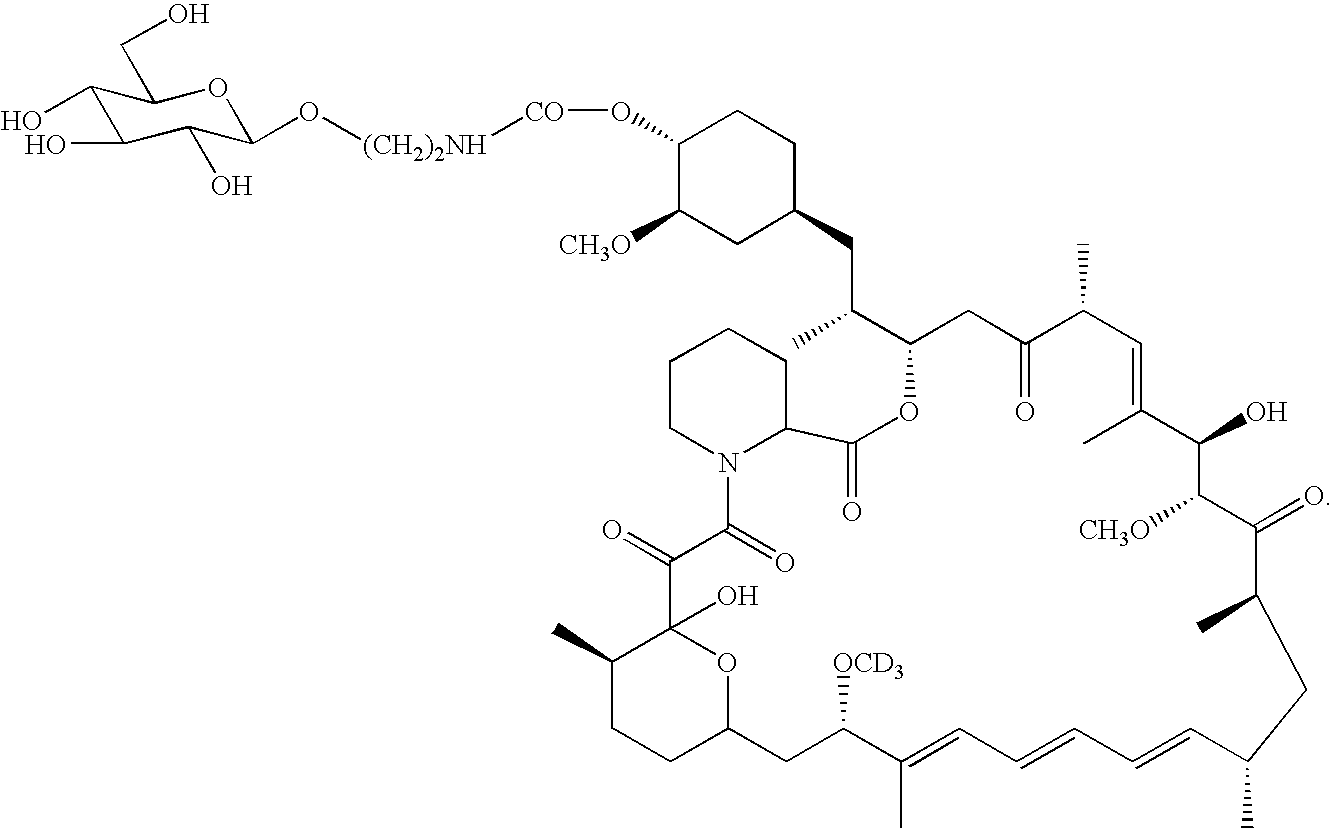Deuterated rapamycin compounds, method and uses thereof
a technology of rapamycin and rapamycin derivatives, which is applied in the field of deuterated derivatives of rapamycin, can solve the problems of increasing the toxicity of the drug, causing large isotopic effects of the drug, and so as to reduce the effect of reducing the c-d bond oxidation rate and reducing the formation of demethylated metabolites
- Summary
- Abstract
- Description
- Claims
- Application Information
AI Technical Summary
Benefits of technology
Problems solved by technology
Method used
Image
Examples
example 1
Preparation of 7-Deuteromethyl Rapamycin (FIG. 1)
[0036]5 mg of Rapamycin was dissolved in 2.5 ml of dichlordmethane. 40 mg of deuterated methanol was added. 10 beads of NAFION® catalyst were added to the above solution. The contents were stirred under nitrogen at room temperature for 14 hours. The reaction was monitored by mass spectrum. The solution was filtered and concentrated The residue was dissolved in dry benzene and freeze dried. The white solid obtained was homogenous by mass spectrum analysis and characterized by LC / MS.
example 2
Preparation of 31, 42 d2-7-deuterated Rapamycin (FIG. 3)
[0037]Rapamycin (11 mM) was dissolved in a mixture of cyclohexane and dichloromethane (1:1) 10 ml. The contents were cooled in ice bath and poly(vinylpyridinium)dichromate 0.5 grams was added. The reaction mixture was stirred overnight and the reaction was followed by mass spectrum. The reaction mixture-was filtered, washed with water and dried using anhydrous magnesium sulphate. The organic solution was filtered and concentrated. The crude product was subjected to purification by silica column using chloroform-methanol (20:10) mixture. The pure fractions were collected and concentrated. The residue was dissolved in benzene and freeze dried. The product was characterized by LC / MS. M+(Na) 932. This material was dissolved in dry ether (10 ml). 10 equivalents of lithium aluminum deuteride was added. The reaction mixture was stirred for 24 hours. After the completion of the reaction, the excess of LiAlD4 was decomposed by the addit...
example 3
Preparation of Glycosylated DeuteroRapamycin (FIG. 5)
[0038]Referring to FIG. 5, compound 10 prepared by example 1 (20 mg) was dissolved in 5 ml of dichloromethane. Dimethylaminopyridine (2.2 mg) was added to the above solution. The contents were cooled to −70 C. 4-Nitrophenylchloroformate in dichloromethane was added to the reaction mixture. The solution was stirred under nitrogen at room temperature for 14 hours. The reaction was followed by mass spectrum. After the completion of the reaction, the reaction mixture was diluted with dichloromethane and the organic solution was washed with water, 0.2M ice cold HCl solution. The organic layer was dried over anhydrous magnesium sulphate. After filtration, the organic solution was filtered and concentrated. The crude product was purified by LC / MS to provide the pure compound 30 (Yield 10 mg.) Compound 30 (0.9 m.mol)was dissolved in dry DMF(0.5 ml) To this mixture, a solution of 2-aminoethyl-a-D-glucopyranoside (7.2 m.mol) was added. The ...
PUM
| Property | Measurement | Unit |
|---|---|---|
| molecular mass | aaaaa | aaaaa |
| hyperproliferative vascular disorder | aaaaa | aaaaa |
| sparingly soluble | aaaaa | aaaaa |
Abstract
Description
Claims
Application Information
 Login to View More
Login to View More - R&D
- Intellectual Property
- Life Sciences
- Materials
- Tech Scout
- Unparalleled Data Quality
- Higher Quality Content
- 60% Fewer Hallucinations
Browse by: Latest US Patents, China's latest patents, Technical Efficacy Thesaurus, Application Domain, Technology Topic, Popular Technical Reports.
© 2025 PatSnap. All rights reserved.Legal|Privacy policy|Modern Slavery Act Transparency Statement|Sitemap|About US| Contact US: help@patsnap.com



